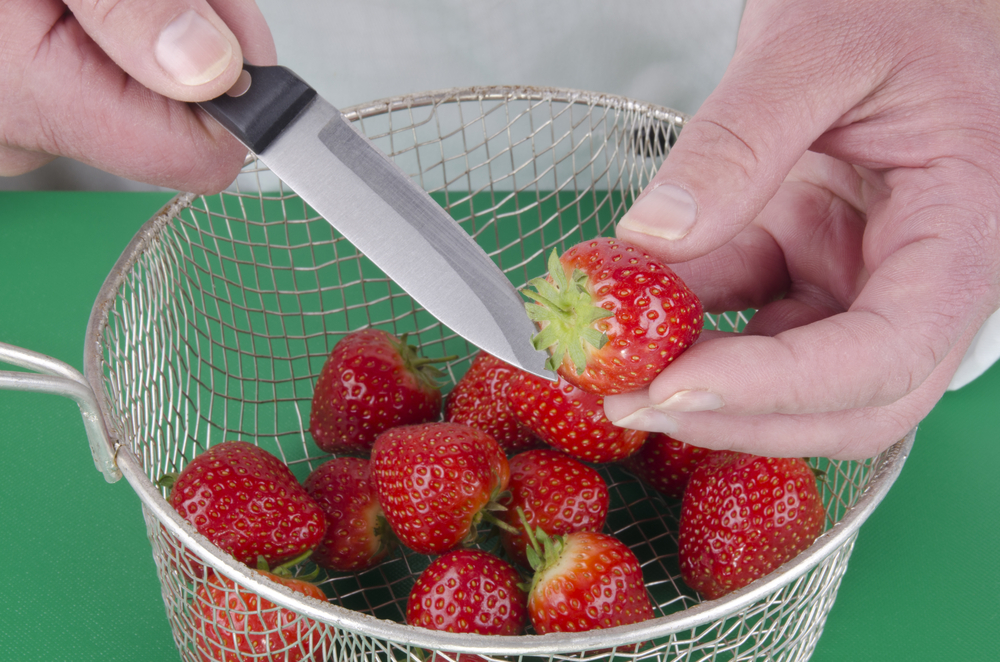- What Safety Measures are Being Taken?
- New Penalties for Contaminating Food
- What Does ‘Contamination’ Mean?
- Food Contamination Penalties in NSW
- How Can Police Prove Your Intention?
- Food Contamination Penalties where Harm or Death is Caused from the Contamination
- What Does ‘Grievous Bodily Harm’ Mean?
- What if the Offender Contaminated the Food Outside NSW?
Share This Article
Array“It’s certainly not a great time to be a farmer”, says a local café owner who buys all her strawberry supplies from Galluzzo’s Fruit Market in Glebe, NSW.
Truck loads worth of strawberries have been taken off the shelves of major supermarket stores following the strawberries needle contamination scare- which has spread throughout Australia.
The Detective Superintendent from the NSW Robbery & Serious Crime Squad, Danny Doherty described the contamination as “an act of treachery” against out nation.
Queensland is Australia’s largest strawberry producer, followed by Victoria who produced 32,790 tonnes of it in 2016/17.
To date, there has not been a confirmation as to the motivation behind why someone would contaminate strawberries by implanting sharp needles in them. Nor have police found any suspects as of yet.
In fact, Queensland police have confirmed that a report that a school girl bit into a strawberry contaminated with a needle was a false report.
Most of the contamination scare involve strawberries, however, in the last 24 hours, there have been reports of other fruits such as bananas and apples being contaminated with needles in Sydney’s West. There has been one report involving a banana from a store in Condell Parl, while there was an apple report from a store in The Ponds, NSW.
NSW Police are currently investigating over twenty fruit contamination incidents across NSW.
Following the Queensland Government’s $1 million fund to support the farmers who have been hard hit by the needle contamination, the Queensland police are now offering a $100,000 reward for anyone who provides enough information to police if it ends up resulting in a conviction.
As a result of the needle contamination, 6 strawberry brand suppliers have now recalled their strawberries as a result of new reports of needles contamination in strawberries in WA and SA over the weekend.
There has been significant financial and emotional loss suffered from the contamination scare. One such example is the Facebook video posted by Stephanie Chheang depicting the dumping of truckloads of the fruit.
- What Safety Measures are Being Taken?
- New Penalties for Contaminating Food
- What Does ‘Contamination’ Mean?
- Food Contamination Penalties in NSW
- How Can Police Prove Your Intention?
- Food Contamination Penalties where Harm or Death is Caused from the Contamination
- What Does ‘Grievous Bodily Harm’ Mean?
- What if the Offender Contaminated the Food Outside NSW?
What Safety Measures are Being Taken?
To restore people’s confidence again, pallets are now being labelled to say that the fruits have been scanned for metal contamination. The fruits are now undergoing metal detector tests at the warehouses.
This still leaves the problem of possible contamination from the time the fruit leaves the warehouse to the time they reach the supermarket stores. In a bid to address this concern, the suppliers are also looking into more secure packaging.
Unfortunately, the supermarket stores don’t appear to be doing much in support. Where a Coles spokeswoman reportedly said that they are working with suppliers “to implement additional control measures to ensure strawberries are inspected before they are sent to supermarkets”.
It is still advised to continue cutting up the strawberries before consuming them.
New Penalties for Contaminating Food
Contaminated fruits have now been discovered in 5 of our nation’s states. In response to the strawberry needle scare, Prime Minister Mr. Morrison intends to now introduce tougher new food contamination laws by increasing the penalty from the current 10 years imprisonment to 15 years imprisonment.
The Prime Minister also intends on introducing a new offence of recklessly contaminating food carrying similar terms of imprisonment in the hope to send a clear deterrent message to anyone who intends to do this.
The new ‘reckless’ offence will make it easier for police to prove the offence of food tampering or contamination in court leading to more convictions.
What Does ‘Contamination’ Mean?
The definition under section 93J of the Crimes Act 1900 (NSW) of ‘contamination’ includes interference with food, or even making it appear to have been contaminated or interfered with.
Interfering with food such as strawberries, bananas, or any fruit, by inserting needles or any other harmful things in it (including poison) would fit within the definition of contamination.
Food Contamination Penalties in NSW
Currently, you can expect to face up to 10 years imprisonment if guilty of contaminating food in NSW under section 93K of the Crimes Act 1900 (NSW).
You will be guilty of contaminating food under section 93K of the Crimes Act 1900 (NSW) if police can prove each of the following elements in court:
- You contaminated the food by interfering with it in some way; and
- You did this with the intention of causing either public alarm/anxiety, or economic loss through the public becoming aware of the contamination.
How Can Police Prove Your Intention?
Unless you make an admission to police that you intended to contaminate the food in the way expressed in the 2nd element noted above, the police can prove you had the intention of causing public alarm or economic loss through public awareness of your contamination by making ‘inferences’ from the surrounding established evidence.
An inference is where the court can make safe connections between other smaller pieces of evidence leading to an obvious conclusion.
For example, often the intention element of this offence (reflected in the 2nd element noted above) can be inherent in the fact that the offender has implanted a needle in a strawberry before placing it back onto a crate that the offender knew will be dispatched to supermarkets around the nation.
Under section 93L of the Crimes Act 1900 (NSW), you can face the same term of up to 10 years imprisonment for making threats to contaminate food with the intention of causing public alarm/anxiety, or economic loss from the public awareness of it.
Food Contamination Penalties where Harm or Death is Caused from the Contamination
You can face up to a term of 25 years imprisonment if guilty of contaminating food that causes grievous bodily harm or death in NSW under section 93O of the Crimes Act 1900 (NSW).
You will be guilty of causing or intending to cause death or grievous bodily harm from contaminating food under section 93O of the Crimes Act 1900 (NSW) if police can prove each of the following elements in court:
- You contaminated the food by interfering with it in some way i.e. implanting a needle within it; and
- You did this with the intention of causing a public alarm/anxiety or economic loss from the public awareness of it; and
- The contamination caused a death or ‘grievous bodily harm’ to a person; or where no death or harm was caused, but you intended to cause death or harm.
Again, as explained earlier, your intention can be inferred by the Court from all the circumstances of the evidence. However, if the accused person is found not guilty of this offence, the Court can still return a verdict of guilty to section 93K if the elements of s93K are satisfied from the evidence.
What Does ‘Grievous Bodily Harm’ Mean?
There can be confusion as to whether an injury is properly categorised under the law as ‘actual bodily harm’ or ‘grievous bodily harm nsw’.
If the injury that the police rely on in the charge against you involves grievous bodily harm, then you will be not guilty to the offence of contaminating food if the injury or injuries don’t amount to ‘grievous bodily harm’ under the law.
Importantly, you will likely be faced with a harsher penalty by the Judge or Magistrate if found guilty for causing grievous bodily harm from contaminating food than if you were found guilty for contaminating food where no harm was caused. In some instances, it can mean the difference between going to prison and avoiding prison as a penalty by the Court.
‘grievous bodily harm’ is considered a more serious extent of injury/harm than ‘actual bodily harm’ under the criminal law. It’s therefore important to know the difference.
‘grievous bodily harm’ is where the injuries of a person involve ‘really serious injury’ which includes permanent or serious disfiguring (i.e. broken bone(s)).
Section 4 of the Crimes Act 1900 (NSW) states that “grievous bodily harm” includes any permanent or serious disfiguring of the person, any grievous bodily disease (where a reference to the infliction of ‘grievous bodily harm’ includes causing a grievous bodily disease to a person), or the destruction of the foetus of a pregnant woman (whether or not she suffers any other harm).
The ultimate question is whether the injury is a ‘really serious injury’.
The case of Swan v R [2016] NSWCCA 79 outlines that other pieces of evidence can assist in determining if it amounts to a ‘really serious injury’ (‘grievous bodily harm’), which predominantly go towards determining if the injury is permanent, including:
- Whether surgery was required
- Whether there was any displacement
- Whether there was or continues to be follow up doctor appointments required as a result
Common injuries that have amounted to ‘grievous bodily harm’ include:
- Brain damage or damage to the skull
- Stab injuries from a knife
- Stitches resulting from bleeding
- Broken ankles
- Fractured legs and arms
- Stitches on a face caused from being ‘glassed’
In contrast, in the usual assault occasioning actual bodily harm cases, the injuries are of a less serious nature.
The case of McIntyre v R 92009) 198 A Crim R 549 at [44] outlines actual bodily harm as including bruising, swelling or scratches that last for some time.
‘Actual bodily harm’ can include bleeding from the ear or head and abrasions on the skin. Generally, it doesn’t include panic or fear.
‘actual bodily harm’ refers to injuries that are considered to be more than transient or trifling. This refers to injuries that involve more than just injuries that quickly subside. Temporary scratches or redness considered minor won’t be categorised as ‘actual bodily harm’.
Some very serious psychological harm or psychiatric injuries may amount to ‘actual bodily harm’ in the way outlines in the case of Li v R [2005] NSWCCA 442.
What if the Offender Contaminated the Food Outside NSW?
Section 93P of the Crimes Act 1900 (NSW) makes it clear that an offender who contaminates food outside NSW where there is enough evidence to satisfy each of the elements explained above can still be prosecuted and sentenced in a NSW Court in accordance with NSW law.
We have experienced local criminal lawyers in Sydney, Parramatta and Liverpool to answer any further questions you may have arising from this blog.
Book a Lawyer Online
Make a booking to arrange a free consult today.
Call For Free Consultation
Call Now to Speak To a Criminal Defence Lawyer
Over 40 Years Combined Experience
Proven SuccessAustralia-Wide
Experienced LawyerGuarantee
 (02) 8606 2218
(02) 8606 2218
 (02) 8606 2218
(02) 8606 2218















